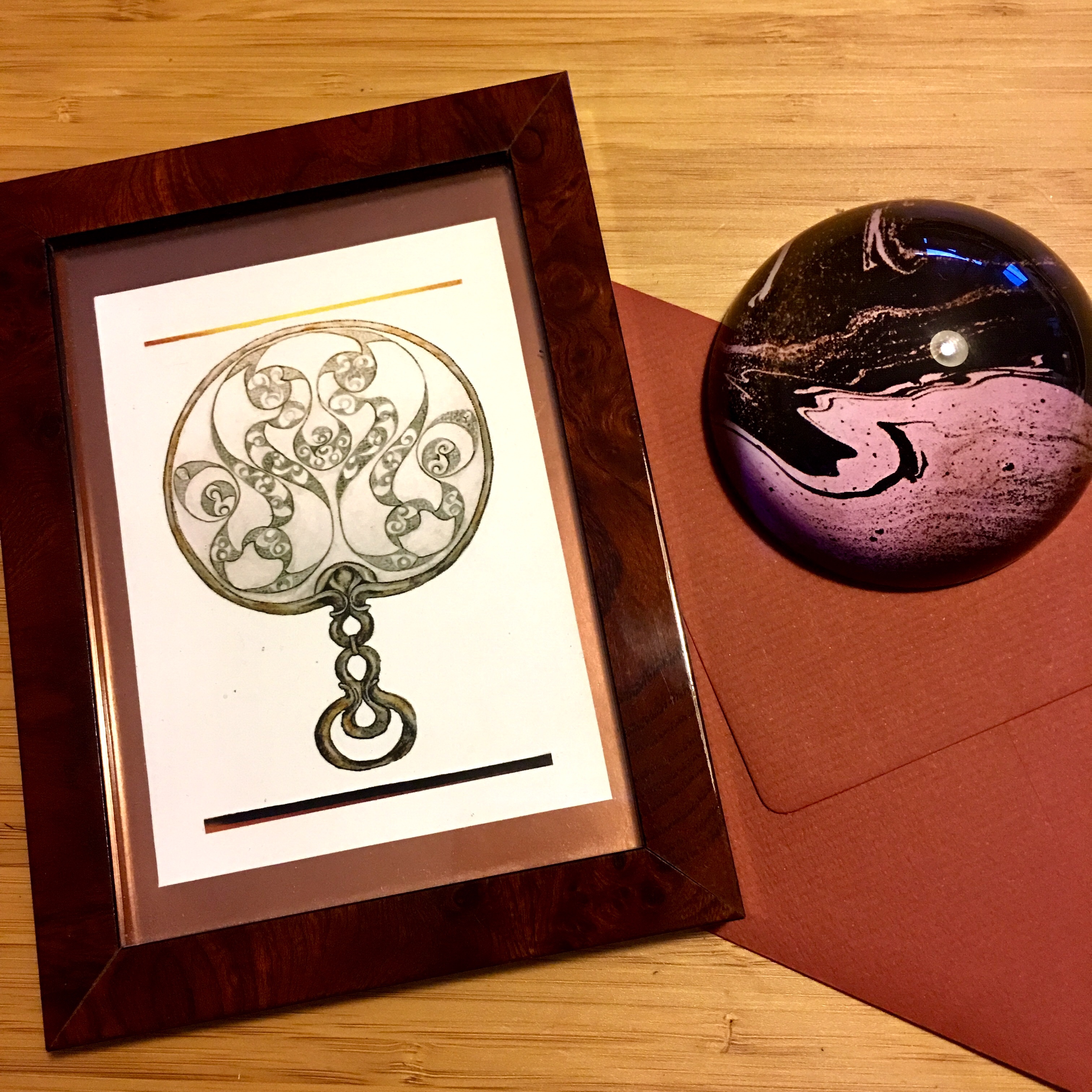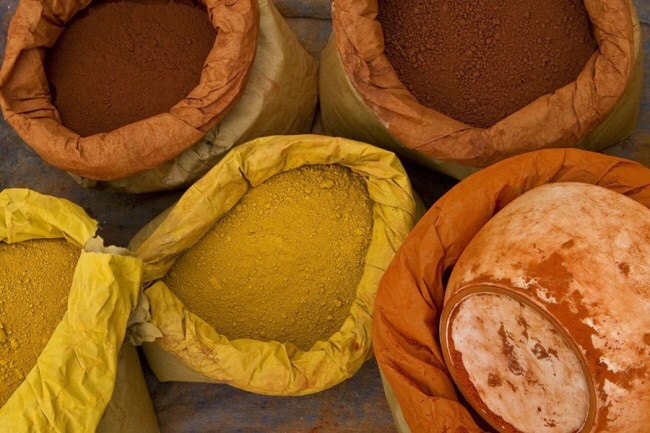‘Who were the Celts?’ a wonderful course at at Oxford Department for Continuing Education gave me so much inspiration. I enjoyed it from the first till the last day and regretted it came to an end. One of the essays I had to read was an essay on Iron Age mirrors. ‘Mirrors in the British Iron Age: Performance, Revelation and Power, by Melanie Giles and Jody Joy.

Iron Age 50 BC – AD 50
Found in 1908 near Desborough
After reading about Iron Age mirrors, I set out to draw the Iron Age Desborough mirror. Through drawing I would gain more insights into its decorations and its function. Iron Age mirrors that were beautifully decorated and made of bronze and iron were found in graves of high status Iron Age women.
I like to say something about high status Iron Age women. One might think ‘high status’ refers to rich women or wives of rulers or kings. But although both accounts can be correct, high status refers in the Iron Age more to women being leaders or shamans.
The essay discusses how Iron Age metallurgy and how a whole community was involved in the making process. Also, it discusses social relations, grave goods, and the compass drawn motifs of repeated and distinctive forms arranged into intricate and flee flowing designs. Fascinating, to say in the least. The question begs why were mirrors used as grave goods? The easiest answer does not always work, one being that the Iron Age lady was buried with her belongings. Perhaps the mirrors were not possessions but (diplomatic) gifts. And why would a deceased lady take a mirror, she wouldn’t need it in her afterlife, or would she?

Imagine looking into this mirror. The effect of seeing your face in the reflective properties of the plate, disrupted or enhanced by its La Tene decorations would …yes, what would you see?
Giles and Joy describe how the decorations on the mirrors are not only used to deceive the eye, but also to reinforce the reflective qualities of the mirror plate. The anthropologist Alfred Gell points out that Iron Age mirrors could have expressed political power and legitimize associations with the supernatural. This is hard for us to understand but in order to understand what Gell states requires us to imagine a time in which you only saw your reflection in (restless or calm) water, in shiny objects, like copper, bronze, silver or gold. How special such mirrors would be! Imagine now that next to not frequently seeing your reflection, you were raised to notice all sorts of shapes in water, smoke, old trees, and rocks. We have a clear sense of what we see is real and what is imagination, but for ancient people perhaps seeing was just seeing, whether it was imagination or fact. If the under-upper and middle world aren’t having hard borders, perhaps seeing imaginative, hallucinative and factual weren’t compartmentalized either.

When I suffer a migraine aura, I see things that do not exist and things that I need to see are gone. I can pass a person in a street who is missing his head! Perhaps looking into an Iron Age mirror yields a similar effect as having a migraine aura because Iron Age mirrors have blanked out spaces and thus provide viewers with a disorienting and distorted image of themselves. Yet, an Iron Age mirror has not only missing parts (blanked out spaces, decorated with a basket woven texture) but carefully chosen synchronized but flow-like playful, witty, and mischievous botanical and animal patterns. What effect would looking into a shiny plate, with a deliberate disorienting pattern have? Here the essay explains more about the ‘technology of enchantment‘ and goes deeper into psychological war-fare though powerful visceral and visual effects. It informs the reader about the Fang People of Gabon who used hallucinogens before looking into mirrors, and states that these Iron Age mirrors were not real mirrors (not for checking hair or make-up). In fact, the mirrors played a role in rituals to release the soul to its afterlife.

During the time that I spent drawing this Iron age mirror, I tried many things. I tried to project my face behind the decorations, fusing my face and the decorations and then see all sorts of animals. Of course, this is a very poor attempt to understand its magic. But I have to do it with a large doses of imagination and hours of drawing as there is no way I would be able to hold the mirror up and have a look in it. And even if I could do that, there wouldn’t be a ritual that would be helpfully performed by an Iron Age shaman who would be experienced in travelling between worlds. (Or brainwaves, or different stages of consciousness, whatever way you might define shamanistic journeying).
My concluding thoughts are that by looking into this mirror, in an Iron Age ritual ceremony, with an Iron Age cognitive mindset, maybe, as a dying lady of high status, I would find great comfort in seeing my old face being obscured with these splendid swirling decorations. I would be calm as I have seen, thanks to my migraines, things that aren’t there and fail to notice things that are there. I would probably enter theta brainwaves the same way as after sitting down for a longer time in meditation or -more Iron Age style- looking into the smoky swirls of an open campfire. I might start seeing my face, combined with the swirly flowing embellishments turning into animal and ancestral spirits.
One has to understand that the Iron Age was full of spirits, spirits we have carefully abandoned from our modern life. But just as they have been forgotten, it doesn’t mean these spirits aren’t there. I would most certainly find an ancestral spirit that would ‘present’ itself as so much of my own face would be blanked out, and only essential and familiar facial lines would still linger in the reflective image. Or perhaps, I would see a beautiful stag or another mammal, and experience it as my guiding spirit animal. Perhaps I would see the hybrid human-animal dressed-up shaman of the village giving me instructions to journey to the Other-world.
All in all, it would perhaps release my soul into an in-between world in which I would be able to project comfortably to what I would need to see. I would probably have been fasting during the last days of my life, I would be susceptible for my imaginative mind to dominate and thus the softly and dreamily reflecting mirror would get a transitional quality and function. Or perhaps I would look and whisper some wise words, like Tibetan shamans who look into mirrors to see the future and the past, wise words that would be helpful to my tribe. The Fang people of Gabon use mirrors to contact their ancestors. Do Iron Age mirrors have a similar function?
Obviously, many things become possible should such a highly valued mirror be available to a tribe. There are many more than this Desborough mirror only. One by one these mirrors and their fascinating embellishments are showing us that Iron Age metallurgy and shamanism practices were interrelated and that highly decorated ‘magic’ Iron Age mirrors were much appreciated by Iron Age peoples.
Paula Kuitenbrouwer
At Etsy
P.S. During the hours that I was drawing the Desborough mirror, I travelled between worlds too. I had to descend from my creative, spiritual plane of manifesting ideas to the mundane world of running errands. As the trees were shedding their leaves, I noticed many decomposed leaves with open parts resembling mini Iron Age mirrors scattered on the street. If you can not enjoy looking into the Desborough Iron Age mirror at the British Museum, do not despair, mini versions are freely available every autumn.
Art cards are available at Etsy (and can be framed as small memories to this exquisite mirror):



Paula holds an MA degree in Philosophy and she is the owner of mindfuldrawing.com. Her pen and pencils are always fighting for her attention nevertheless they are best friends; Paula likes her art to be brainy and her essays to be artistic.
Paula’s art shop is at Etsy and her portfolio is at Instagram. Contact her freely should you like to commission her or buy her art.



- The Artist’s Life
- Swedish Death Cleaning or Döstädning & Dementia
- Swedish Death Cleaning Part 3.
- Swedish Death Cleaning Part 2.
- Self Portrait



